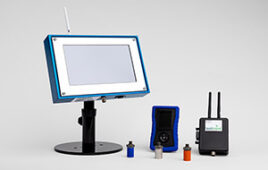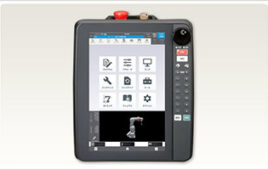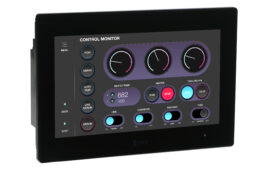Machine automation users will benefit from mobile HMI developments related to interfaces and 5G connectivity.
By Leandro Coeli, partner, ADISRA LLC
As we enter the emerging era where humans and machines will collaboratively work together to turn data into knowledge, the human-machine interface (HMI) will play an increasing role in this expanding digital transformation. A first step is digitization, where physical actions and analog signals are converted into digital form. More significant is digitalization, which is the use of technologies to transform business processes and enable new value creation or revenue models.
One trend in the path to digitalization is the shift from centralized or localized processes to a decentralized architecture, where mobility of the HMI becomes key. Ongoing development in the industrial internet of things (IIoT) space is creating opportunities for disruptive industry models, in turn spurring the progress of new HMI technologies.
Expanding the interface
Current HMIs are display-based and use touchscreens, keyboards, and pointing devices. The future of HMIs will include a wider range of interfaces such as natural language processing, augmented reality (AR), virtual reality (VR), and voice-based HMI.
HMIs will become aware of passive user inputs, such as location. This will allow a user to receive notifications regarding the health of an item of equipment when they are close by, using HMI software on their mobile device to locate themselves and the equipment (Figure 1).

Mobile HMIs can be made location-aware, so users automatically receive notifications and visibility for nearby equipment. Courtesy of ADISRA
Mobile HMIs are also evolving to be more intuitive and accessible on multiple form factors, such as watches, wearables, and other kinds of emerging control devices. According to IDC, the market for wearables is expected to grow 9.4% in 2020 with 368.2 million shipments and reach 526.8 million shipments by 2024 (Reference 1). For industrial automation users, wearables are becoming popular for improving productivity and safety.
No matter what form factor the HMI possesses, it needs to collect and represent the most important data so users can generate the insights needed to solve their business use cases.
The role of mobile HMI
Successful digitization and subsequent digitalization efforts will rely on IIoT hardware, software, and networking elements—but will face foundational challenges with connectivity and security. The right mix of data collection, analysis, visualization, and alerts can make mobile HMI a key part of the technology mix. All digitized plant or machine data can deliver benefits and should be connected. Mobile HMIs can operate close to the devices and equipment to source this data and are thus well-placed to be part of any digital transformation solution.
Remote connectivity, either through a gateway or directly to the field device, allows users to monitor and troubleshoot their equipment, whether they are standing next to it or thousands of miles away, minimizing downtime and saving unnecessary trips to the site. Many machine builders and systems integrators now install their equipment and systems to provide extensive connectivity to remote project sites for monitoring, and even to operate distributed machines as a service.
The most capable HMIs are built on the latest technology to deploy applications on mobile devices using standards such as HTML5 and OPC UA. At a minimum, operators need to remotely monitor and make informed decisions about situations happening with their equipment, and then act upon that information. Well-designed HMIs help them easily visualize and identify important information such as key performance indicators (KPIs) and overall equipment effectiveness (OEE) (Figure 2).

At a minimum, modern HMIs must deliver good visualization on any mobile platform, whether the user is near the target machine or across the world. Courtesy of ADISRA
5G empowers mobile HMI
On-site mobile HMI first became practical when Wi-Fi offered sufficient performance, and similarly, off-site remote HMI became practical once cellular data connectivity achieved sufficient throughput. The next step in this evolution is 5G.
Manufacturing use of remote and mobile HMI will be transformed by 5G. Currently in the USA, there are six carriers offering 5G technology in specific cities, while Europe has fourteen carriers offering 5G. In the wireless IIoT WANscape, there are three main 5G use cases:
–Massive Machine Type Communication (mMTC)
–Enhanced Mobile Broadband (eMBB)
–Ultra Reliable Low Latency Communications (URLLC)
mMTC provides scalable connectivity with wide area coverage. This use case is based on large numbers of devices. Some good examples of applications would be smart cities, smart metering, and smart logistics.
eMBB is more suited for high data rates and data driven applications with wide spectrum range, such as immersive video conferencing and 3D video.
URLLC supports ultra-reliable and low latency connectivity for mission critical and real-time applications, with a design goal of sub-millisecond latency and error rates below one millisecond. Potential applications include autonomous vehicles, smart grids, factory automation, robotic control, and AR/VR applications.
With 5G technology available in some cities, mobile HMI can access greater data capacity with a reduction in latency while maintaining security standards. Sensors, controllers, remote machine monitoring, and operator HMI actions will benefit due to performance gains as compared to traditional technologies.
According to a recent study by GSMA, a trade association representing the interest of global mobile network operators, 5G will contribute $657 billion to the North American economy over the next 15 years, with 19% of this amount coming from manufacturing and utilities (Reference 2).
While digital consumers are a large part of 5G adoption, the focus on 5G for industrial automation has been increasing over the past few years. The 5G Enabled Manufacturing (5GEM) project created a manufacturing production system life cycle example with design, deployment, operation, and maintenance phases based on wireless and mobile 5G-communication.
The four phases of the project demonstrated:
–a networked and cloud architecture
–5G communication focused on monitoring and predictive maintenance
–information distribution to connected machine operators and unmanned vehicles
–cloud scanning for radio planning, involving radio propagation competence.
This project proved that 5G could be effectively deployed for industrial automation.
HMIs and the Digital Twin
Another area where mobile HMI technology plays an increasing role is with digital twins. A digital twin is the virtual representation of a physical object or machine. Operators can use HMIs to explore potentially costly installations and changes in the virtual digital twin world, without risk, before applying these changes in the physical world (Figure 3).

New 5G technology is poised to deliver a responsive HMI experience, even for emerging high-bandwidth applications like AR/VR and digital twins. Courtesy of ADISRA
Furthermore, users can collect and examine data from a digital twin to develop better understanding, learning, and reasoning regarding machine operation and performance. Digital twins integrate well with HMI technology, generating a more flexible and interactive mode for improving machine efficiency and operation safety. Simulation solutions like this are becoming practical with the rapid response time provided by 5G, needed to exchange large amounts of data between mobile HMIs and digital twins.
Security and integrity
Because 5G technology was designed to support various mission critical use cases, it offers a built-in security system and authentication, much improved when compared to prior mobile standards. Both authentication and key management are critical components for cellular networks for protecting operators, networks, and the communication between device and user. 5G mobile networks also have additional services such as assurance audit, strong end-to-end encryption, and multiple identification methods that can be customized for different use cases.
Until 5G becomes more prevalent, operators can implement Multi-access Edge Computing (MEC) with Long Term Evolution-for Machines (LTE-M). LTE-M, and more specifically LTE Cat1, provides fast data rates (up to 1 Mbps), fully mobile clients, and is compatible with 5G. The use of MEC enables operators to control the routing of specific cellular data traffic for processing at the edge of the network. It allows cellular traffic for low-latency and security-sensitive use to be prioritized. MEC identifies high-priority and low-priority data based on the operators’ settings.
Next generation machine mobile HMI
Traditional HMIs used for machine visualization are a mature technology and mobile HMIs are becoming more commonplace. However, the newest mobile HMIs are gaining impressive interface, computing, analytical, and locational awareness features. These developments assist operators by providing easy access for monitoring equipment health and rich information about machine operating conditions so they can respond quickly to reduce machine downtime.
Increasing adoption of 5G connectivity provides high network availability and bandwidth combined with low latency, enabling HMIs to interface with advanced solutions like digital twins. Advanced mobile HMIs and their supporting technologies are a key piece of the digital transformation journey for automated machinery.
ADISRA, LLC
www.adisra.com
Figures, all courtesy of ADISRA
Reference 1: Worldwide Wearables Market Braces for Short-Term Impact Before Recovery in 2020, According to IDC, https://www.idc.com/getdoc.jsp?containerId=prUS46138520
Reference 2: The Mobile Economy, North America, https://www.gsma.com/mobileeconomy/wp-content/uploads/2020/03/GSMA_MobileEconomy2020_North_Am.pdf
Filed Under: Factory automation, DIGITAL TRANSFORMATION (DX), Displays • HMIs • operator interfaces • monitors




